Text

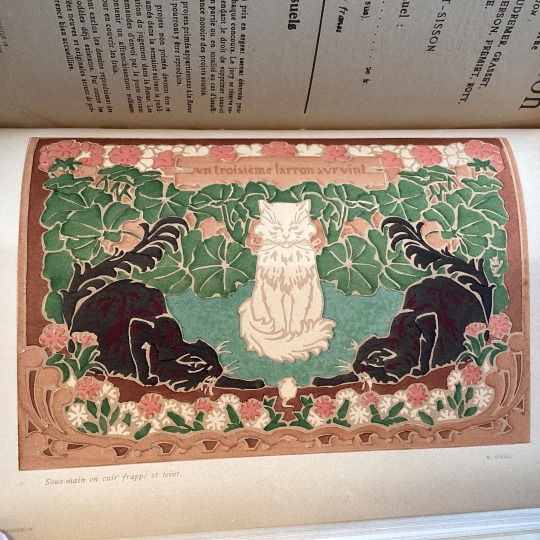
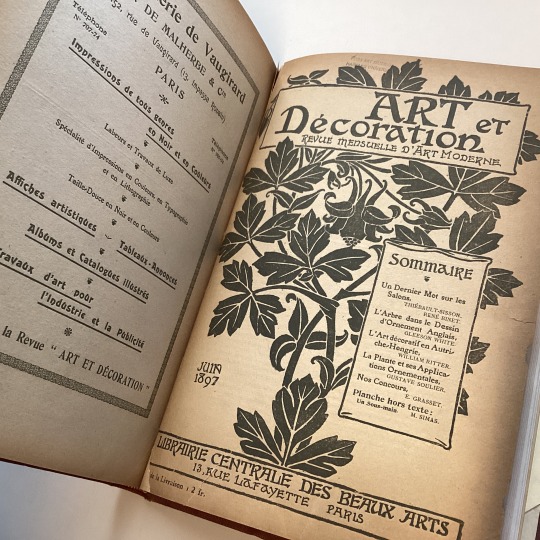
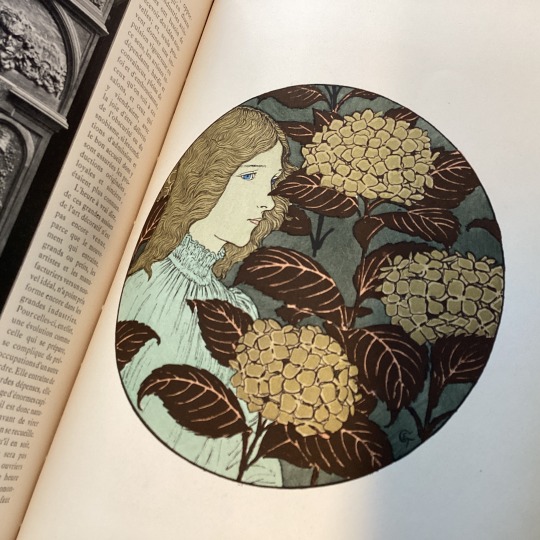
April is National Decoration Month.
Art et décoration was first published in 1897. The publication was suspended during the two World Wars from August 1914 – April 1919, and from 1939 through 1945. The Fine Arts Library has the original volumes if you want to see them. Request to view them in the Special Collections Study Room!
Art et décoration : revue mensuelle d'art moderne
Cover title: Art et décoration et l'architecture 1936-37
Paris : Librairie Centrale des Beaux Arts,
Frequency note: Monthly
French
HOLLIS number: 990062486850203941
#NationalDecorationMonth#Decoration#ArtEtDecoration#SpecialCollections#HarvardFineArtsLibrary#Fineartslibrary#Harvard#HarvardLibrary
237 notes
·
View notes
Text
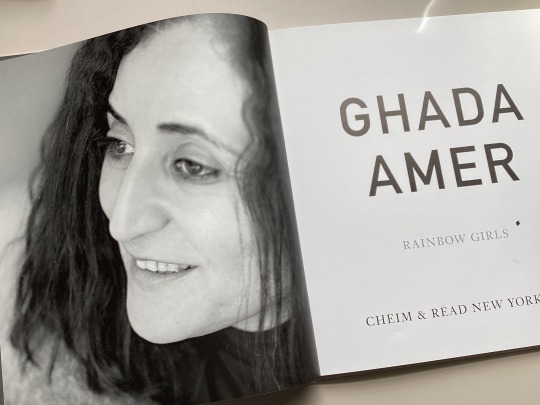




“I decided to use embroidery in my work after realizing that the language of painting is dominated by men.” – Ghada Amer
Ghada Amer (b. 1963) is an Egyptian-American contemporary artist who uses embroidery in her work. Amer’s work deals with issues of gender and sexuality, and she is known for highly layered embroidered images of women’s bodies often referenced from pornographic imagery.
Amer emigrated from Egypt to France at the age of 11 and currently lives and works between New York and Paris. In 1987, she attended a semester abroad program with the School of the Museum of Fine Arts in Boston, and she learned about important women artists who were using different formal languages. After returning to France, Amer developed her own approach to painting, using embroidery and gel on canvas as her medium and creating her own “feminine language of painting.” (from an interview with Maura Reilly in 2010)
"Many of Amer's paintings make art historical references in subversive and humorous ways. White Girls and White-RFGA subtly makes racial commentary, critiquing whiteness as a convention while addressing Robert Ryman. Landscape with Black Mountains-RFGA conflates the female form as a pastoral setting.[SW1] ” (from the publisher’s note: Cheim &Read, 2018)
Image 1: Ghada Amer, photo by Nat Gory
Image 2: “Belle” 2014, acrylic, embroidery, and gel medium on canvas, 72”x 64”
Image 3: Detail
Image 4: “The Fortune Teller” 2008, acrylic, embroidery, and gel medium on canvas, 50”x 60”
Image 5: Book cover featuring detail from “White Girls” 2017, acrylic, embroidery, and gel medium on canvas. 64”x 72”
Ghada Amer
New York, NY : Cheim & Read, 2018.
HOLLIS number: 990153139110203941
Ghada Amer : rainbow girls
New York : Cheim & Read, 2014.
HOLLIS number: 990146953240203941
Ghada Amer : color misbehavior
New York : Cheim & Read, 2010].
HOLLIS number: 990126578000203941
#GhadaAmer#ArabAmericanMonth#ArabAmericanArtist#ArabAmericanWomenArtist#ArabAmericanWomen#Embroidery#HarvardFineArtsLibrary#Fineartslibrary#Harvard#HarvardLibrary
8 notes
·
View notes
Text
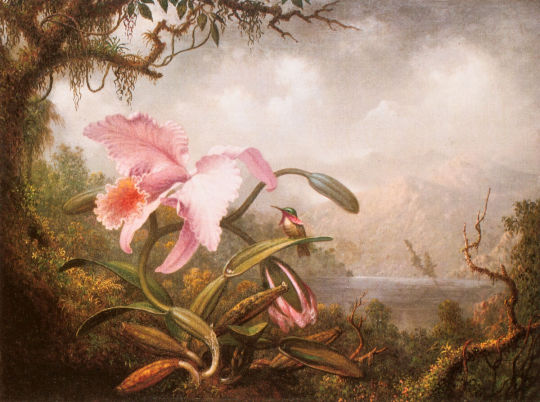
Happy National Orchid Day!
Orchid and hummingbird
Heade, Martin Johnson, 1819-1904, American
ca.1885
Oil on canvas
15 x 20 1/8"
Repository: Fine Arts Museums of San Francisco, San Francisco, San Francisco, California, United States
HOLLIS Number: olvwork199203
This image is part of FAL’s Digital Images and Slides Collection (DISC), a collection of images digitized from secondary sources for use in teaching and learning. FAL does not own the original artworks represented in this collection, but you can find more information at HOLLIS Images.
#NationalOrchidDay#Orchid#Painting#HarvardFineArtsLibrary#FineArtsLibrary#Harvard#HarvardLibrary#DigitalImages
59 notes
·
View notes
Text

Rest in Power, Faith Ringgold.
Faith Ringgold died at 93 on Saturday at her home in Englewood, New Jersey.
Faith Ringgold was born in Harlem in New York City in 1930. She was best known for her storytelling quilt work. This was the time after the golden era of the Harlem Renaissance, but the neighborhood was still beaming with much excitement and creativity. Ringgold grew up as the third child in a working-class family, often sick with asthma, such that she spent a lot of time making drawings and imagining that “the bridge was the magic highway to the rest of the world.” Later Ringgold used the imagery of bridges in “The Woman on a Bridge Series.”
Ringgold was a trailblazing artist, educator, and activist. For seven decades, she used art as her platform to speak out against racism, sexism, and inequality. Through her storytelling and visual art, Ringgold challenged the status quo in the society.
Faith Ringgold : a view from the studio
Attribution: Curlee Raven Holton, with Faith Ringgold.
Holton, Curlee Raven.
Boston : Bunker Hill Pub. in association with Allentown Art Museum, 2004.
English
HOLLIS number: 990095910410203941
#FaithRinggold#AmericanBlackArtist#BlackWomenArtist#HarvardFineArtsLibrary#Fineartslibrary#Harvard#HarvardLibrary
28 notes
·
View notes
Text
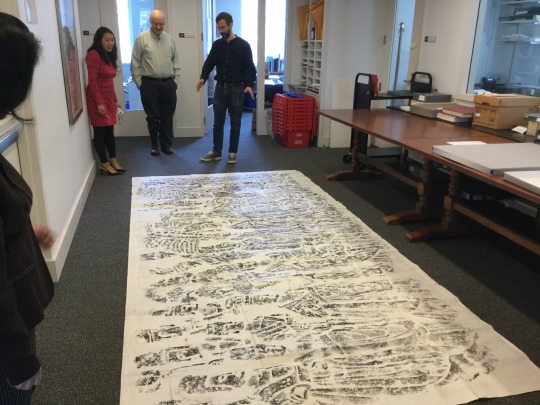
It’s National Library Week this week!
Did you know that we are home to more than books? This is one example of the unique materials that you can view in the Special Collections Study Room at the Fine Arts Library.
Image: Researcher, Fletcher Coleman with librarians, viewing a large-scale Chinese rubbing on the floor, photographed in 2017.
#NationalLibraryWeek#Rubbing#AsianArt#SpecialCollections#HarvardFineArtsLibrary#Fineartslibrary#Harvard#HarvardLibrary
5 notes
·
View notes
Text
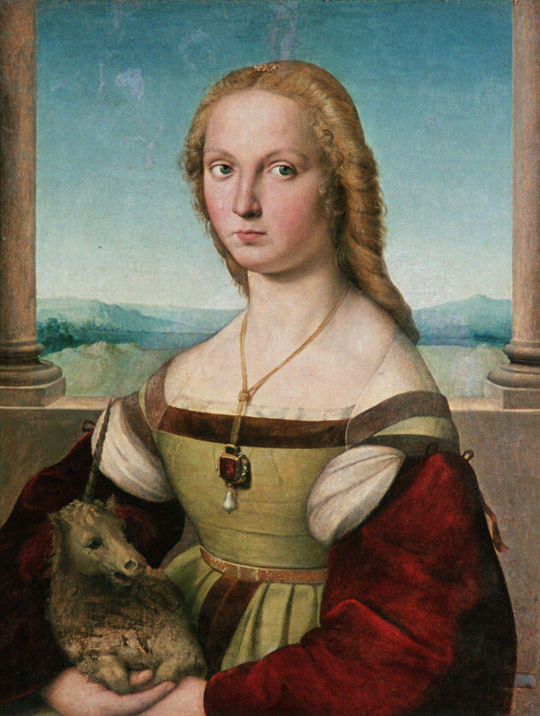
Happy National Unicorn Day!
Unicorn was a symbol of chastity in medieval romance. There’s an interesting story behind this painting by Raphael. The 1959 restoration work on the painting revealed through radiography the image of a small dog under the unicorn. The dog may have been used as a model for the final appearance of the unicorn!
Lady with a unicorn
Raphael, 1483-1520, Italian [artist]
1500-1505
Oil on canvas laid on panel
67 x 56 cm.
Italian
Repository: Villa Borghese, Rome, Roma, Lazio, Italy
HOLLIS Number: olvwork61413
This image is part of FAL’s Digital Images and Slides Collection (DISC), a collection of images digitized from secondary sources for use in teaching and learning. FAL does not own the original artworks represented in this collection, but you can find more information at HOLLIS Images.
#NationalUnicornDay#Raphael#ItalianPainting#Unicorn#HarvardFineArtsLibrary#FineArtsLibrary#Harvard#HarvardLibrary#DigitalImages
14 notes
·
View notes
Text
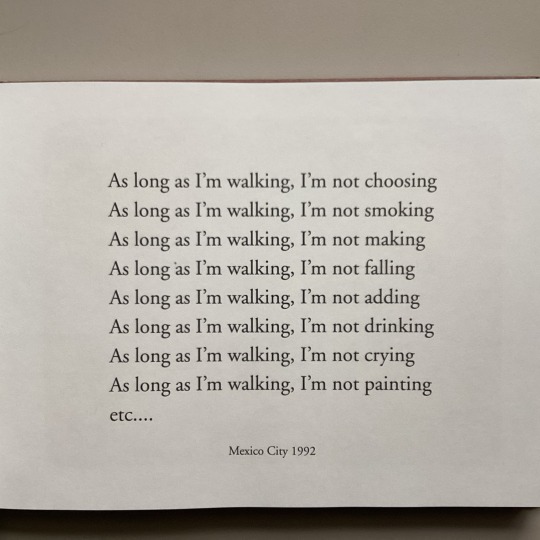


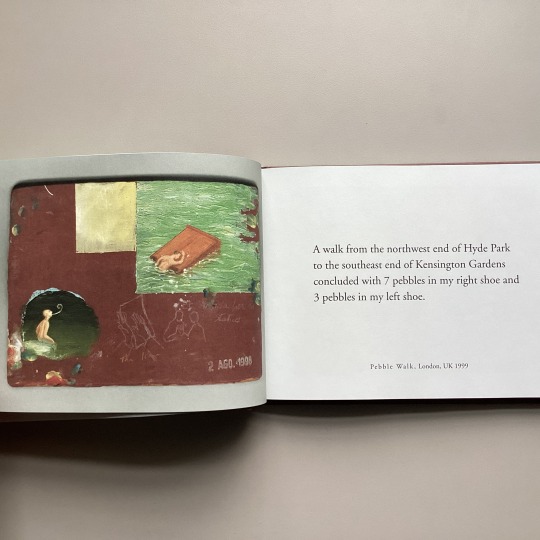
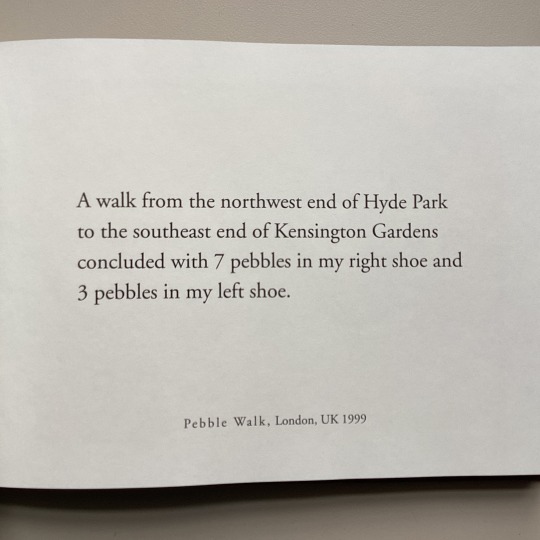

We had fun brainstorming for National Walking Day post yesterday, so here’s another one about walking. But we’re seeing some snow showers today here in Cambridge. Not a good day for walking. We can’t wait for the spring to arrive!
Francis Alÿs (b. 1959) is a Belgian-born, Mexico-based artist who creates a diverse body of artwork spanning from performance, social practice, video, and paintings. And walking has been an important element in his work throughout his career.
In 1991, Alÿs dragged a small magnetic toy dog on wheels throughout the streets of Mexico City to collect any metallic residue lying in its path (“The Collector”). In 1995, he took a walk after unravelling the sweater he has on, leaving an ever-lengthening, blue-thread trail in his wake. (“Fairy Tales”).
This small publication is a record of a unique series that has been described as a storyboard or archive of Alÿs’ oeuvre, polyptych of 111 paintings called le temps du sommeil. The intriguing images are paired with the words, or instructions, behind his past and future performances.
Le temps du sommeil
Francis Alÿs ; catalogue editor, Catherine Lampert.
Dublin : Irish Museum of Modern Art ; Milano : Charta, [2010]
English
HOLLIS number: 990123544680203941
#FrancisAlys#FrancisAlÿs#Walking#WalkingAsArt#HarvardFineArtsLibrary#Fineartslibrary#Harvard#HarvardLibrary
15 notes
·
View notes
Text
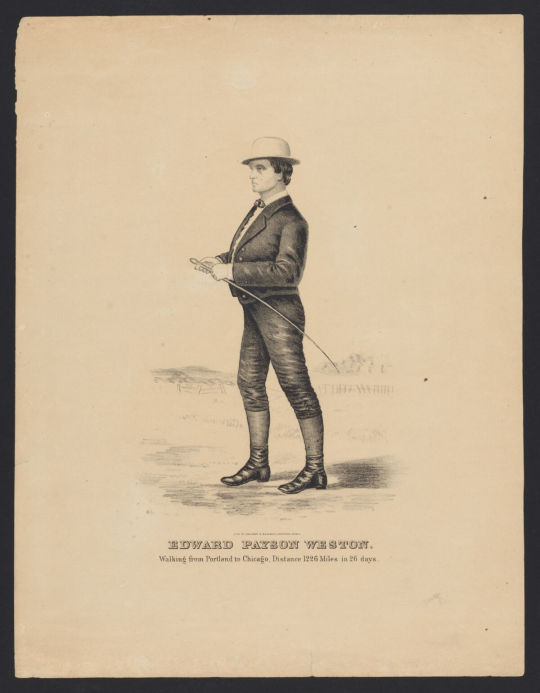
Happy National Walking Day!
Pedestrianism, a form of competitive walking, became popular in the late eighteenth and nineteenth centuries in Britain and Ireland, and spread in the United States.
Racers walked for hundreds of miles around a track in six-day races and the one who walked the furthest distance was the winner. In the United States, watching people walk was the most popular spectator sport in the late 1880s.
Edward Payson Weston (1839–1929) was an American pedestrian. He became famous when he walked 478 miles from Boston, Massachusetts to Washington, D.C. in 10 days and 10 hours, from February 22 to March 4 in 1861. During the walk, he faced snow, rain, and mud, fell several times, and ate while walking.
This portrait is entitled, “Edward Payson Weston Walking from Portland to Chicago.” It must be from 1867 when he covered over 1,200 miles in 26 days. He won a prize of $10,000, but also received several death threats from gamblers who bet against him. He lived to be 90 years old.
We have many other portraits of pedestrians like Weston in our collection of Portraits of boxers and other athletes!
Edward Payson Weston walking from Portland to Chicago
Kellog & Bulkeley, printer.
43cmx33cm
Harvard Fine Arts Library, Special Collections VSCO230.00310 VSCO230
HOLLIS number: olvwork734269
#NationalWalkingDay#SpecialCollection#EdwardPaysonWeston#Pedestrian#Walking#HarvardFineArtsLibrary#Fineartslibrary#Harvard#HarvardLibrary
19 notes
·
View notes
Text
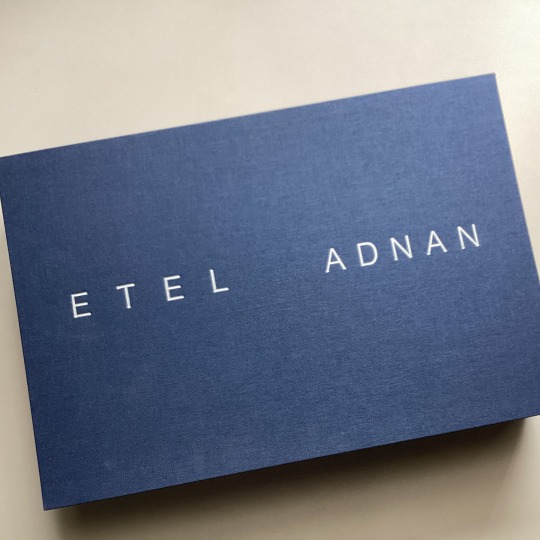


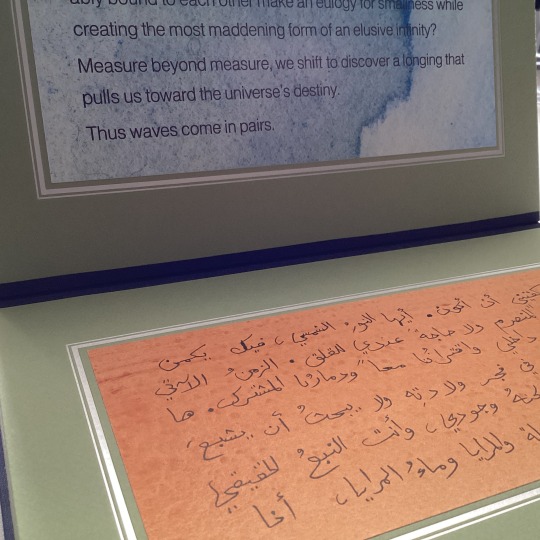
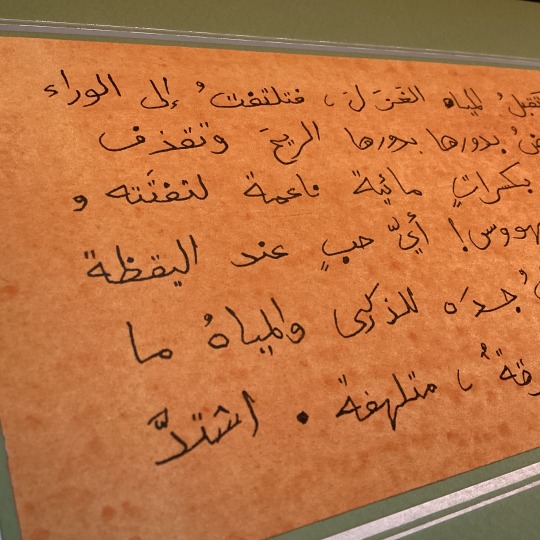
April is Arab American Month and National Poetry Month.
“I write what I see and I paint what I am.” – Etel Adnan
Etel Adnan (1925 – 2021) was a Lebanese-American poet, philosopher, writer, and visual artist. Adnan had been painting for several decades and made visual works in a variety of media including artist’s books, films, and tapestries.
Adnan was born in Beirut, Lebanon to a Greek Catholic mother and a Muslim-Turkish father, who was a high-ranking Ottoman officer born in Damascus, Ottoman Syria. She grew up speaking Greek and Turkish in a mostly Arabic-speaking society. After enrolling at a French Lebanese Catholic School at the age of five, her primary language became French and her early works were written in French. She also studied English in her youth, and most of her later work was written in English. Adnan studied philosophy at the Sorbonne, the University of California at Berkeley, and Harvard University, later teaching philosophy at San Rafael’s Dominican College from 1958 to 1972.
Adnan’s love of language and interest in Arabic calligraphy is evident in her visual art, especially in leporellos, little books with folded concertina-style pages. But color was also language to Adnan, and one can sense that in her paintings.
Later in her life, Adnan openly identified as lesbian. She was survived by her partner, Simone Fattal, who is also a visual artist.
The Fine Arts Library owns Adnan’s artist’s book entitled “The Book of the Sea.” The work is made up like a sample book of Arabic calligraphy handwritten by Adnan, presenting the poems in Arabic and in English, with the original text and translations facing each other.
The book of the sea
Etel Adnan ; bound by Thomas Zwang.
Livre de la mer. English & Arabic
Poestenkill, N.Y. : Kaldewey Press, 2010.
1 volume (unpaged) ; 21 x 31 cm.
Edition Kaldewey ; v. 53
English and Arabic
HOLLIS number: 99156665172003941
#EtelAdnan#ArabAmericanArtist#ArabAmericanMonth#LebaneseAmericanPoet#LebaneseAmericanArtist#HarvardFineArtsLibrary#Fineartslibrary#Harvard#HarvardLibrary#SpecialCollections#NationalPoetryMonth
10 notes
·
View notes
Text
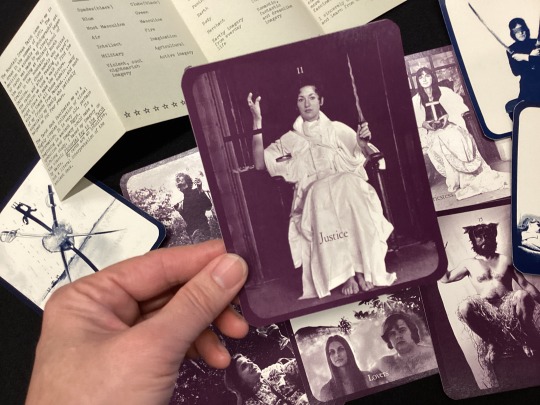



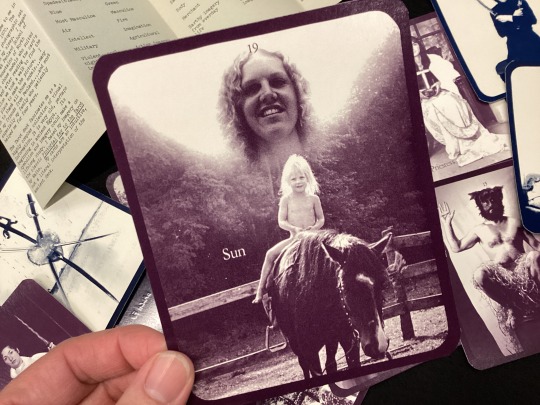
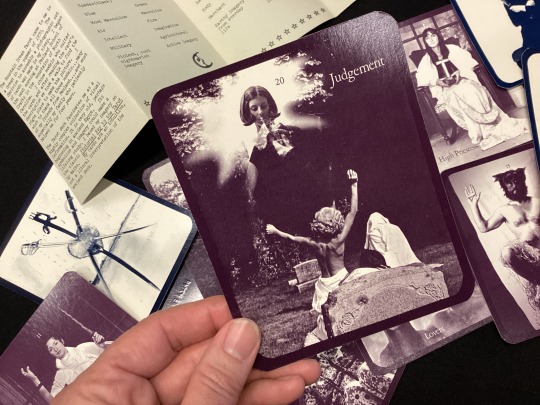
“The Mountain Dream Tarot came to me in a dream in the summer of 1970. The decision to assemble a photographic set of cards was made in my sleep. I began the next morning at Penland School in North Carolina. I chose models who suited the cards and after reading the card's description we took a walk to find the right place to make the picture ... I based my imagery on the classic Pictorial Key to the Tarot by Arthur Waite. My cards are an intuitive, not a literal interpretation of the deck.” – Bea Nettles from the original 1975 introduction.
Bea Nettles (b. 1946) is a photographer and writer known for experimenting with alternative photographic processes. In 1975, Nettles created a set of monochrome photographic tarot cards to foretell the future. The Fine Arts Library owns the third edition of these tarot cards. You can request this set and other tarot card decks in the Special Collections Study Room!
Mountain dream tarot : a deck of 78 photographic cards
Nettles, Bea, 1946-
3rd edition. 2012
78 cards ; 14 x 9 cm in drawstring bag
English
HOLLIS number: 99157019479903941
#WomensHistoryMonth#BeaNettles#SpecialCollections#TarotCards#MountainDreamTarot#HarvardFineArtsLibrary#Fineartslibrary#Harvard#HarvardLibrary
11 notes
·
View notes
Text



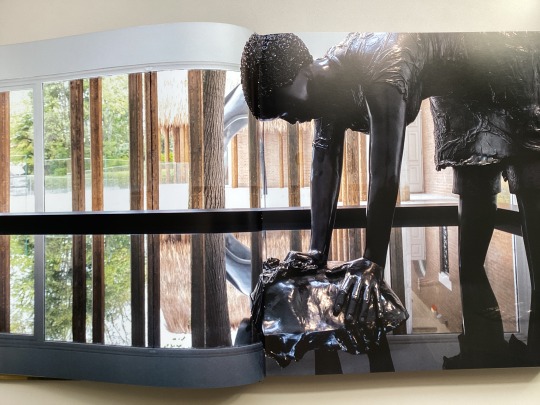
“In order to tell the truth, you need to invent what might be missing from the archive, to collapse time . . . to formally move things around in a way that reveals something more true than fact.”
Simone Leigh (b. 1967) is an American artist whose work focuses on explorations of community, Black feminism, and the traditions and material culture of the African diaspora. Over the past two decades, Leigh has created artwork that situates questions of Black femme-identified subjectivity at the center of contemporary artistic discourse. Her sculpture, video, installation, and social practice explore ideas of race, beauty, and community in visual and material culture. Leigh often draws her concepts and inspirations from anthropological, historical, and colonial archives that represent stereotypical views of black women through a European lens. She creates new forms incorporating her research on these archives with African aesthetics and Black feminist concepts.
In 2022, Leigh was the first black woman to represent the United States in the Venice Biennale.
Image 1: A large head sculpture that is work-in-progress in her studio
Image 2: Untitled, 2022, stoneware
Image 3: Brick House, 2019, bronze
Image 4: Last Garment, detail, 2022, bronze, steel, metal, filtration water pump, water
Simone Leigh
Edited by Eva Respini.
Boston : Institute of Contemporary Art/Boston ; New York : DelMonico Books, [2023]
HOLLIS number: 99157252441903941
#WomensHistoryMonth#SimoneLeigh#BlackWomenArtists#WomenArtists#Sculpture#HarvardFineArtsLibrary#Fineartslibrary#Harvard#HarvardLibrary
18 notes
·
View notes
Text
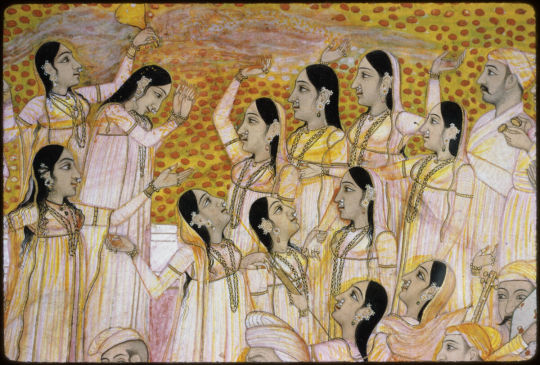
Happy Holi!
The spring "Festival of Colors" has been a popular subject of Indian painting for centuries; here is a detail of a relatively large panoramic scene produced at the court of the Nawabs of Avadh in present-day Uttar Pradesh in the 1760s:
'Celebrating Holi,' Avadh, c. 1760-1764
Harvard Fine Arts Library, Special Collections
SCW2016.12421
#Holi#AvadhiPainting#IndianPainting#IndianArt#1760s#DigitalImages#HarvardFineArtsLibrary#HarvardLibrary
41 notes
·
View notes
Text
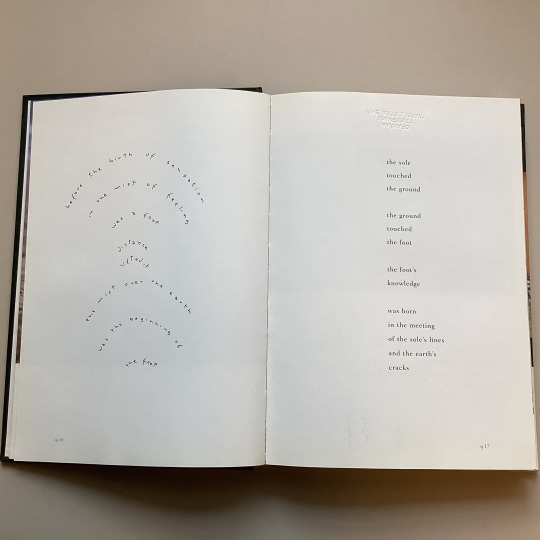


Happy World Poetry Day & Women’s History Month!
Cecilia Vicuña (b. 1948) is a Chilean poet and artist based in New York and Santiago, Chile. Vicuña has been creating a body of impermanent, participatory work she calls “lo precario” (the precious) since the mid-1960s.
Vicuña’s multi-dimensional works begin as a poem, an image that morphs into a film, a song, a sculpture, or a collective performance. These ephemeral, site-specific installations in nature, streets, and museums combine ritual and assemblage.
Her work calls attention to the politics of ecological destruction, cultural homogenization, and economic disparity, particularly the way in which such phenomena disenfranchise the already powerless.
The precarious : the art and poetry of Cecilia Vicuña
Edited by M. Catherine de Zegher
Added t. pg. title: Quipoem
Hanover, N.H. : University Press of New England, c1997.
HOLLIS number: 990076946700203941
#WorldPoetryDay#CeciliaVicuña#WomensHistoryMonth#Poetry#WomenArtist#Quipoem#HarvardFineArtsLibrary#Fineartslibrary#Harvard#HarvardLibrary
13 notes
·
View notes
Text
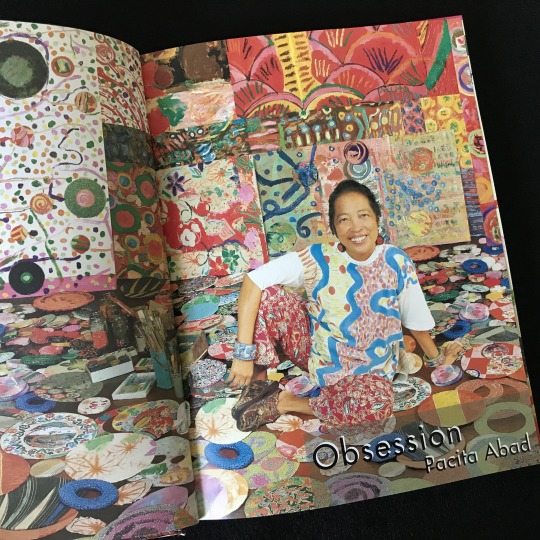
A Filipino-American artist Pacita Abad (1946-2004) was born in Batanes, Philippines, and lived in Philippines until her parents urged her to leave Manila in 1970. As a law student, Abad had begun to organize demonstrations opposing the dictatorial regime of Ferdinand Marcos. Her organizing activities led her and her family in Manila to become targets of political violence. Abad took her parents’ advice and left Philippines. She enrolled at the University of San Francisco to study Asian history while supporting herself as a seamstress and a typist.
Abad became interested in art and eventually became a global artist. She has lived in many countries, including Bangladesh, Yemen, Sudan, Papua New Guinea, and Indonesia, incorporating many different techniques and styles she encountered in her travels into her artwork. Abad would sew, stitch, and collage objects such as stones, sequins, glass, buttons, shells, and mirrors onto painted canvas to create vibrantly colorful works.

Fortunate for those who can visit Harvard, Abad’s work is now being shown as a part of “Future Minded: New Works in the Collection” at the Harvard Art Museums, which is free to the public.
Image 1: Pacita Abad featured in the publication, Obsession
Image 2: “The Great Barrier Reef,” 1991. Mixed media. Currently being exhibited at the Harvard Art Museums.
Obsession
Pacita Abad; [catalogue edited by Jack Garrity; with essays by Ian Findlay-Brown and Ruben Defeo].
[Singapore : Pacita Abad Foundation], c2004.
English
HOLLIS number: 990107751490203941
#WomensHistoryMonth#PacitaAbad#FilipinoAmericanArtist#WomenArtist#HarvardFineArtsLibrary#Fineartslibrary#Harvard#HarvardLibrary#harvard art museums
15 notes
·
View notes
Text


A Hungarian-born American artist, Agnes Denes (b. 1931) is a pioneer in environmental, ecological, and conceptual art. Her family survived the Nazi occupation in WWII and migrated to Sweden before settling in the United States.
In 1982, Denes planted a 2-acre wheatfield on a landfill in Manhattan two blocks away from the Wall Street and the World Trade Center. Against the backdrop of Wall Street, this golden wheatfield stood for four months and mesmerized many New Yorkers. Denes said in regard to this work, “… the work had to have a meaning, a strong message, and, of course, the paradox. … the work turned out to be one block from Wall Street, facing the Statue of Liberty, for which this country stands, in the middle of traffic in a bustling city. A large golden field of grain on land meant for the rich, on expensive real estate.” (From an interview with Ulrich Obrist)
Today, more than forty years after she created this monumental work entitled “Wheatfield – A Confrontation: Battery Park Landfill, Downtown Manhattan,” her vision touches even more deeply given the ever-increasing degradation of our environment, the ongoing mismanagement of land and food systems, and the widening divide between the poor and the wealthy—all the result of corporate capitalism, as well as geopolitical control of resources.
Denes said that this work represented “food, energy, commerce, world trade, economics” and referred to “mismanagement, waste, world hunger.” She also said, “My decision to plant a wheatfield in Manhattan, instead of designing just another public sculpture, grew out of the longstanding concern and need to call attention to our misplaced priorities and deteriorating human values.”
At the age of 88, Denes finally had her retrospective at the Shed in New York in 2019. This publication presents more than 130 works from the exhibition, spanning the artist’s entire 50-year career.
Agnes Denes : absolutes and intermediates
New York, NY : The Shed, [2019]
English
Catalog of an exhibition held at The Shed, October 9, 2019-January 19, 2020.
HOLLIS number: 99153868498803941
#AgnesDenes#WomensHistoryMonth#EnvirontalArt#EcologicalArt#Wheatfield#WomenArtist#HarvardFineArtsLibrary#Fineartslibrary#Harvard#HarvardLibrary
107 notes
·
View notes
Text

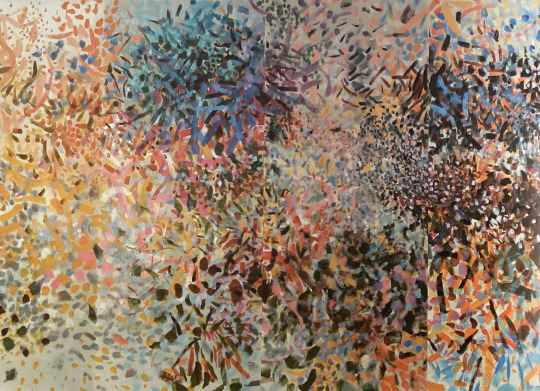

This month during Women’s History Month, we are honoring many trailblazing women artists.
Palestinian American artist, scholar, and art historian, Samia Halaby (b. 1936) is known for her vibrant abstract work. Halaby was eleven years old when she and her family were displaced from Palestine to Lebanon in 1948. In 1951, Halaby emigrated to Ohio in the United States. She was educated in the American Midwest and became a trailblazer when there were few female abstract painters. In her work, Halaby draws inspiration from her homeland—the textures and landscapes of Palestine such as native trees and Islamic architecture and geometry.
Image 1: Book cover
Image 2: “Mountains of Palestine,” detail, 2000, Acrylic on polyethylene, 72”x 172”
Image 3: “Mountains of Palestine” and studio view
Samia Halaby : five decades of painting and innovation
[text, Maymanah Farhat].
Halaby, Samia.
Added t. pg. title: Sāmiyah Ḥalabī : khamsat ʻuqīd min al-rasm wa-al-ibtikār
سامية حلبي : خمسة عقود من الرسم والابتكار
Beirut : Ayyam Gallery, [2010]
English
French
Arabic
HOLLIS number: 990129614060203941
#SamiaHalaby#WomensHistoryMonth#WomenArtists#PalestinianAmericanArtist#AbstractArtist#HarvardFineArtsLibrary#Fineartslibrary#Harvard#HarvardLibrary
12 notes
·
View notes
Text

In honor of Women’s History Month
Women Artists in Revolution (WAR) created this poster to protest the Whitney Museum of American Art’s 1969 Annual (later became Biennial), which included only eight women artists out of the 143 artists shown.
WAR was a New York City-based collective of American women artists and activists formed in 1969. It was formed out of the “inhospitable atmosphere of the Art Workers’ Coalition (AWC),” which had a number of separate affinity groups including the Guerrilla Art Action Group, but was male-dominated and often sidelined women members and their causes.
In 1970, WAR members sent letters to the Whitney Museum and the Museum of Modern Art, demanding that both museums change their policies to be more inclusive of women artists.
It was not until the 2010 Whitney Biennial that more than half of the artists shown were women. For the upcoming 2024 Biennial, fewer than a quarter of the artists use he/him pronouns.
Women artists together : art in the age of women's liberation
Tobin, Amy, 1989- [author]
New Haven ; London : Yale University Press, 2023.
English
HOLLIS number: 99157153582903941
#WomenArtistsInRevolution#WomensHistoryMonth#WomenArtists#Activism#HarvardFineArtsLibrary#Fineartslibrary#Harvard#HarvardLibrary
5 notes
·
View notes